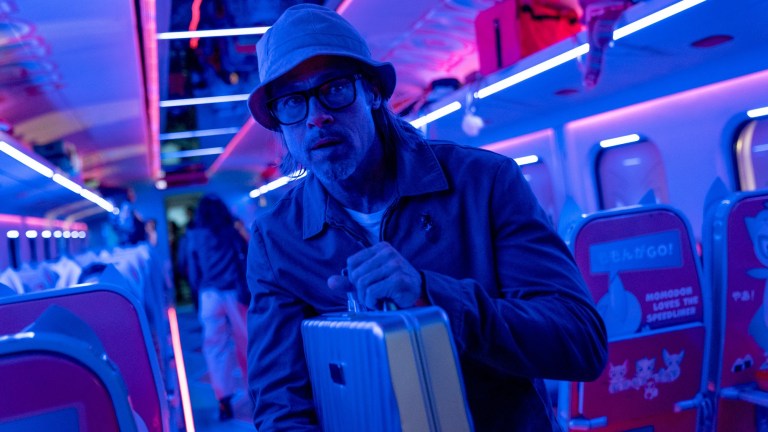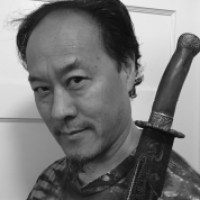Is Bullet Train Guilty of Whitewashing?
Brad Pitt takes the lead in Bullet Train, but should his role have gone to a Japanese actor instead? We examine the controversy around the new release.

This Bullet Train article contains some spoilers.
Bullet Train comes barreling into theaters loaded with a heaping helping of gratuitous violence. This is no surprise from director David Leitch, who began his career as a stuntman, specifically Brad Pitt’s stuntman. Consequently, Leitch is a master at delivering action and ultra-violence on a grand scale.
The title reflects this and its setting, with the Shinkansen, a 50+ year old network of high-speed railways, colloquially known as the “bullet train” in Japan. Since it began, there has not been a single passenger fatality or injury on board these lines due to either derailments or collisions. That all changes in Leitch’s Bullet Train where a sword through the throat is standard operating procedure.
Bullet Train is based on the 2010 Japanese novel, Maria Bītoru (Maria Beetle), by bestselling author Kōtarō Isaka. This book was translated into English last year and retitled Bullet Train to match the movie, which was then in production. The novel’s titular character is not Pitt’s character Ladybug; it’s his character’s handler Maria, who is played by Sandra Bullock in the movie.
Given its Japanese origins and setting, some Asian American advocate groups have called out the casting of Bullet Train as whitewashing. Pitt is clearly not Japanese, nor are several of the other actors cast in leading roles. With the recent success of several Asian-led films like Crazy Rich Asians, Parasite, Shang-Chi and the Legend of the Ten Rings, and Everything Everywhere All At Once, another whitewashed film feels like a step backwards.
But is Bullet Train as guilty of whitewashing as the past Hollywood movies it’s been lumped into?
The War Against Whitewashing
In the era of #stopasianhate, Hollywood whitewashing has become a hot button topic. Some notable offenders included Tilda Swinton as the Ancient One in Doctor Strange and Scarlet Johansson as Major Motoko Kusanagi in Ghost in the Shell. Being branded as a whitewashed film has had varying impact upon box office results. It had a minimal effect upon Doctor Strange, which still performed well. By contrast, Ghost in the Shell was critically panned in part due to its controversy, which fed into the narrative of its subsequent flopping at the box office.
Meanwhile a whitewashing complaint led Ed Skrein to relinquish the role of Ben Daimio in Hellboy: Rise of the Blood Queen, a gesture that was praised by Asian American advocates. He was replaced by Daniel Dae Kim. Despite that, this film also bombed, but that was also attributed to negative reviews and audience reactions.
Like so many issues of race today, whitewashing is complicated, so it is important to distinguish between whitewashing and adaptations from different countries. Films like The Seven Samurai and The Magnificent Seven, Park Chan-Wook’s Oldboy and Spike Lee’s Oldboy, or the upcoming HBO TV adaptation of Parasite where rumors have attached Mark Ruffalo to play the father, might be considered “whitewashing” (or the like) to vitriolic reactionaries. However, if such adaptations are painted with the whitewashing brush, what becomes of classic adaptations like Throne of Blood? Did Akira Kurosawa Japanese-wash Shakespeare’s Macbeth? Did he do the same again when he adapted King Lear into Ran? And what of Money Heist: Korea? Is that K-washing Money Heist?
Adaptations by other nations are more homage than cultural appropriation when done respectfully. The key element here is respect.
The Ancient One, Kusanagi, and Daimio have all been depicted in comics and anime as Asian. So when they were cast in live-action films with non-Asian actors, it’s not some redux from another nation; it is clearly whitewashing. They dishonor the source material. If Bullet Train is to be branded as a whitewasher, the original book Maria Bītoru must be examined.
Is Ladybug Even Japanese?
In Maria Bītoru, Pitt’s character is named Nanao, a distinctly Japanese name. Nanao is a non-binary name—it can be used by either a male or a female. The Na in Nanao means ‘seven,’ like the seven spots on a ladybug. Consequently, Nanao’s nickname is Tentoumushi, which means Ladybug. Still, each chapter that focuses on his story arc is titled ‘Nanao.’ Maria Bītoru is divided into chapters named after the characters that they focus upon, so along with ‘Nanao’ the other chapters include “The Prince,” “Kimura,” “Fruit” (for Lemon and Mikan), and others. It’s arguable who is the main protagonist as each of these characters are given relatively equal weight. That’s much of the charm of how Isaka weaves his novel.
Unlike the book, Maria dubs Pitt’s character with the new code name Ladybug at the beginning of the movie Bullet Train. And like any book-to-movie adaptation, many liberties are taken with the story. Bullet Train ends completely differently than Maria Bītoru. While in the book, the character is named Nanao and the Ladybug nickname is just a side story, in the movie, it’s all about Ladybug.
Generally, Isaka doesn’t waste time describing the physical characteristics of his characters. Their names are given, and they jump right into the action. The bulk of character development is built through dialogue. Nanao is introduced without any distinguishing features. It’s assumed that he’s Japanese because of his Japanese name, but perhaps it was an adopted name, akin to Jackie Chan taking Jackie as a stage name to appease western audiences. Isaka leaves his characters’ physical appearance to the reader’s imagination.
Which of Original Characters are Japanese?
While many of the characters have Japanese names, several of the main assassins use racially ambiguous code names. It’s Isaka’s writing device, giving the novel a more universal appeal. His assassins could be of any race. Wolf is only described as having long hair full of dandruff and missing some teeth (courtesy of Nanao from some previous altercation). In Bullet Train, Wolf is played by Bad Bunny, and his backstory has a Latino interpretation.
Lemon and Mikan (Mikan means Tangerine) are described as not being related but looking almost identical, so they are often mistaken for twins. This is subverted in the movie for comic effect in the film. Brian Tyree Henry is Black and plays Lemon while Aaron Taylor-Johnson is white and plays Tangerine. Even beyond their skin color, they look nothing like each other, which becomes a running joke throughout the film when they are referred to as twins. Given the novel’s ambiguity, these casting choices can be justified.
The Hornet is major divergence in the film as well as a red herring for fans that have read Maria Bītoru. First believed to be male in the book, it’s a big reveal when Nanao discovers the Hornet is a woman, and yet another reveal when it’s implied that there might be two Hornets—an assassin duo. Unlike the film, the Hornet is the Snack Trolley Girl, perhaps in cahoots with the Conductor. In the movie, Karen Fukuhara from The Boys plays the Concessions Girl and Masi Oka from Heroes plays the Conductor, so book-reading fans have an expectation given that casting. When Zazie Beetz appears as the Hornet in an entirely new disguise, it’s a shock after reading the book.
The film takes biggest liberties with the arch villains. The book’s villain Minegishi is supplanted by the ironically names White Death (Michael Shannon). These roles are completely different from each other in characterization and story arc. And the Prince, a.k.a. Satoshi Oji, is a schoolboy who looks almost like a girl in the book. In the movie, the character has a complete gender flip, and she’s played by Joey King.
This isn’t to say that none of the characters in the movie are Japanese. Bullet Train cast two of the hottest Japanese actors who’ve achieved recent global attention, Andrew Koji as Kimura and Hiroyuki Sanada as the Elder (Kimura’s father). It can be argued that Kimura is the main protagonist of the book, perhaps in the movie too. And while Kimura’s father plays a role in the book, it’s not as significant as in the movie, especially not in the climactic finale. Sanada’s role is greatly expanded in the picture.
The author Isaka has spoken publicly about the racial ambiguity of his creations. In a recent New York Times article, Isaka embraced the international cast, saying that his characters were “not real people, and maybe they’re not even Japanese.” He added, “I don’t have any feeling of wanting people to understand Japanese literature or culture. It’s not like I understand that much about Japan either.” If the author himself regards his characters as ethnically malleable, who are we to judge?
Inclusivity vs. Asian Representation
What Bullet Train does with its interracial cast is akin to what director Peter Brook did with his critically acclaimed adaptation of the Indian classic The Mahabharata. While there is no question that the original characters were Indian, Brook’s cast was daringly colorblind. It lent a universality to the epic tale. While comparing an action romp like Bullet Train to a celebrated adaptation of one of India’s most treasured legends may seem like a stretch, the intention is similar.
Leitch’s cast is multicultural—Japanese, white, Black, and Latinx—making the film more inclusive. It’s akin to introducing some actors of color into Vikings: Valhalla and Bridgerton. Isaka welcomed Pitt as the lead for his character. He appreciates that Pitt’s global star power will be a rapid vehicle to bring more worldwide attention to his work. Hopefully, Bullet Train is a steppingstone for more of Isaka’s novels to become films.
There’s no denying the celebrity of Pitt and his power as a box office draw. While it might have been exciting to see an Asian lead play Ladybug, disregarding the exceptional performances of Koji and Sanada here does more to hurt Asian representation movement than help the cause. If Bullet Train brings more spotlight to Isaka’s work, perhaps Koji can be the lead for a movie adaptation of one of his other two novels. Koji and Sanada have been delivering fantastic work, and Bullet Train showcases their talents well. It would be such a pity if a whitewashing claim overshadowed their momentum.
Bullet Train is in theaters now.
